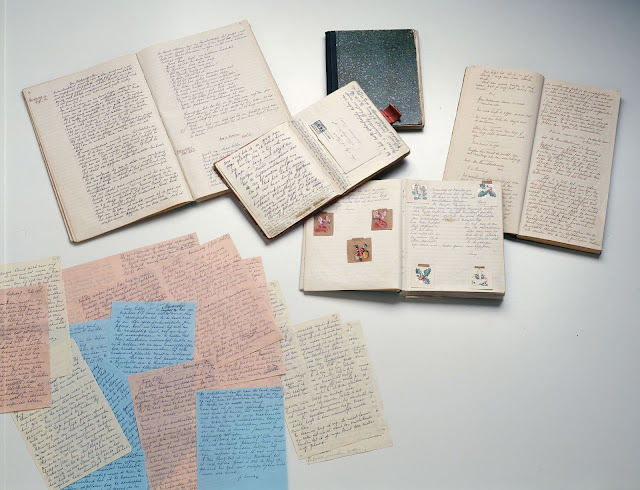Her diary became one of the symbols of the tragic fate of millions of people of Jewish descent, persecuted and murdered by the Nazis during World War II. A Jewish girl from Germany, Anne Frank, began writing it at the age of 13 in a shelter in Amsterdam. The shelter was probably revealed, and not even sixteen-year-old Anne died in March 1945 in the Bergen-Belsen concentration camp, which was liberated just a month later by the British army. The diary was published 75 years ago, on June 25, 1947.
The diary contains memories, reflections, unfulfilled desires, and everyday experiences of a girl. There are not many books that have received so many editions and translations and that would shake Europe's conscience so deeply. The diary has several versions. The author later reworked the original notes and improved them literally. In addition, the first Dutch publisher removed the young author's sexual views from the book. Her father, on the other hand, did not agree that readers should learn that, according to his daughter, he did not understand his wife. Only later did the notes come out complete.
Frank left the original records of his daughter in a will to the Dutch State Institute for War Documentation in Amsterdam. The diary has been translated into more than 70 languages and sold over 30 million copies and has inspired several plays and films. It was first published in Czech in 1956. The house on Amsterdam's Prinsengracht, where Anne and her family hid, was visited by 1.3 million people in 2019. The pandemic of a new type of coronavirus then affected the museum's attendance.
Anne was born on June 12, 1929, in Frankfurt am Main to the Jewish family of bank clerk Otto Frank. When she was four years old, Adolf Hitler came to power and a family of four (Anne had an older sister Margot) fled to the Netherlands.
"From May, with good times, it started to go downhill: first the war, then the surrender and invasion of the Germans, and there was poverty for us Jews,"
Anne describes the beginning of the bad times in the mid-1940s.
The refuge in the back wing of the Amsterdam house, which housed the Opekta company founded by Otto Frank, was built by her far-sighted parents for more than a year. After the threat of transport became topical, the Frank family moved into hiding on July 5, 1942, and lived in isolation for more than two years. They were joined by the family of a former Frank's business partner and a Jewish dentist - a total of eight people.
In August 1944, when the shelter was revealed, its inhabitants were transported to concentration camps, and the same fate befell two men who helped the fugitives. Except for Anna's father, all the people died in hiding. Anne and Margot were sent to Bergen-Belsen, where they died of typhus in short succession in March 1945 - a month later the camp was liberated by the British army. The arrest was led by police officer Karl Silberbauer and his assistants from the Dutch police. Justice was at least partially served by Nazi hunter Simon Wiesenthal, with whose help Silberbauer was detained in the 1960s.
Anne's last lines were written three days before her arrest, and some of the records are telling.
"I see the world slowly turning into a wasteland... I feel that millions of people are suffering. But when I look up to heaven, it seems to me that everything will somehow turn for the better, that this horror will end, that peace and tranquility will return."
she wrote, for example, in July 1944.
The diary, whose authenticity is sometimes questioned by Holocaust deniers, was found on the floor by two Opekt employees who helped the Franks in the worst of times, and they also handed the diary to Frank after the war. Anna's father, who returned to Amsterdam from Auschwitz, died in 1980.
According to the Austrian writer Melissa Müllerová, the author of one of Anna's biographies, the hiding Jews were revealed to the Nazis by a cleaning lady from a house on Prinsengracht. British writer Carol Lee claims that he was one of Otto Frank's former business partners.
The museum, which is dedicated to the legacy of one of the most famous victims of the Holocaust, stated that it is possible that the eight people who have been hiding in the building of today's museum since July 1942, no one mentioned. The Nazi occupation administration could only come to shelter by accident during a raid, which was connected with an investigation into illegal work or falsification of allotment tickets.
There are several other similar dailies. In 2006, the diary of the Czech girl Věra Kohnová, who is sometimes presented as "Czech Anne Frank", was published.
Anne FrankThe notes of the Jewish young man Otto Wolf, who was murdered by other Nazis in the village of Zákřov together with another man, are also compared to the Anne Frank Diary.
Also known are the Terezín diaries of Petr Ginz, who died in Auschwitz and whose name became world-famous when his drawing of the Moon was taken into space by the first Israeli cosmonaut Ilan Ramon, who died in February 2003 with the entire crew of the space shuttle Columbia.
Leningrad schoolgirl Táňa Savičevová recorded the dates of death of all family members during the German blockade of Leningrad until she finally died in July 1944 at the age of fourteen as a result of suffering.





